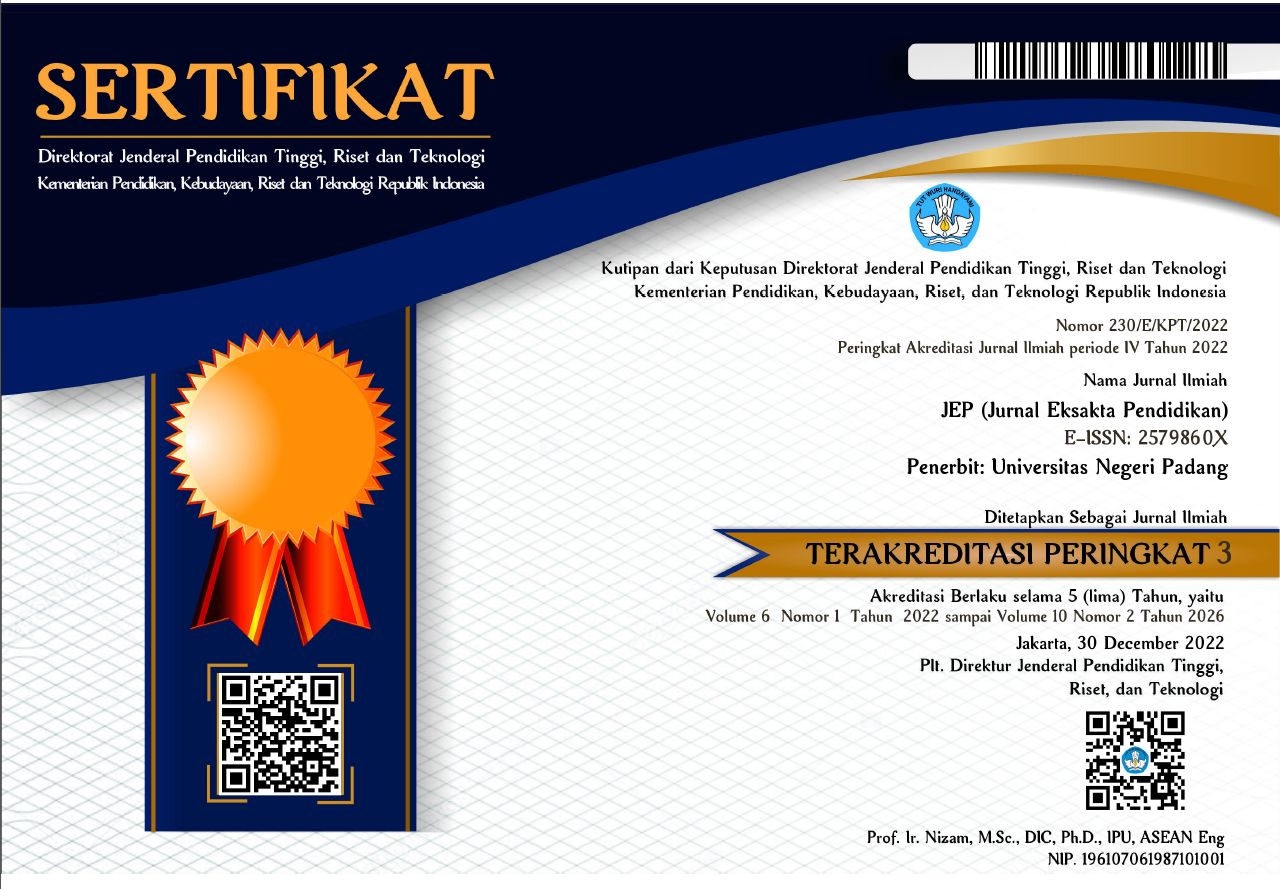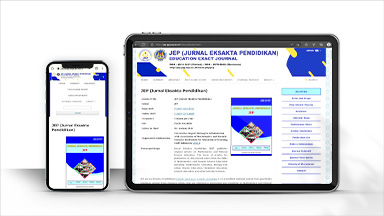Peningkatan Penalaran Ilmiah Siswa melalui Pembelajaran Guided Inquiry Berstrategi Scaffolding pada Materi Suhu dan Kalor
Abstract
The purpose of this research was to analyze the students’ scientific reasoning skills in the guided inquiry learning integrated of scaffolding in heat and temperature. The research used mixed-method with embedded experimental design. The subject of this research was 29 students of class X in Sidoarjo state high school. The instrument consists of treatment and measurement instruments. The treatment instruments consist of syllabus, lesson plan, and student worksheet. The measurement instrument consists of scientific reasoning skills test. The test development based on scientific reasoning pattern proposed by Lawson with a reliability of 0.848. The quantitative data on students’ scientific reasoning skills was analyzed using Wilcoxon-test, while qualitative data was analyzed by reducing data and coding using a scientific reasoning pattern rubric. The results show that students’ scientific reasoning skill in heat and temperature increased after following the guided inquiry learning integrated of scaffolding. The students have been able to use information to determine whether a conclusion is likely to be true or not, but students are still unable to recognize and interpret relationships in situations described by observed or abstract variables.
Downloads
References
Alwan, A. A. 2011. Misconception of Heat and Temperature Among Physics Students. Procedia Social and Behavioral Sciences, 12: 600–614.
Bhat, M. A. 2014. Construction and Evaluation of Reasoning Ability Test. Journal of Educational Studies, 1(2), 47-52.
Blanchard, M. R., Southerland, S. A., Osborne, J. W., Sampson, V. D., Annetta, L. A., & Granger, E. M. 2010. Is Inquirypossible in Light of Accountability?: A Quantitative Comparison of The Relative Effectiveness of Guided Inquiry and Verification Laboratory Instruction. Science Education, 94(4), 577–616.
Chu, H. E., Treagust, D. F., Yeo, S., And Zadnik, M. 2012. Evaluation of Students‟ Understanding of Thermal Concepts in Everyday Contexts. International Journal of Science Education, 34(10): 1509-1534.
Coletta, V.P., Phillips, J. A., Savinainen, A. & Steinert, J.J. 2008. Comment on “The Effects Of Students’ Reasoning Abilities on Conceptual Understanding and Problem-Solving Skills in Introductory Mechanics”. European Journal of Physics, 29(5): 25—27.
Cresswell, J. W. dan Clark, P. 2007. Designing and Conducting Mixed Methods Research. California: Sage Publication, Inc.
Fortus, D., Adams, L. M. S., Krajcik, J., and Reise, B. 2015. Assessing the Role of Curriculum Coherence in Student Learning About Energy. Journal of Research in Science Teaching, 52(10), 1408-1425.
Lawson, A.E. 2004. The nature and development of scientific reasoning: A synthetic view. International Journal of Science and Mathematics Education, 2(3), 307–338.
Makar, K., & Rubin, A. 2009. A framework for thinking about informal statistical inference. Statistical Education Research Journal, 8(1), 82-105.
Mcneill, K. L. & Krajcik, J. 2008. Inquiry and Scientific Explanations: Helping Students Use Evidence and Reasoning, 121-134.
Erlina, E., E Susantini., Wasis. 2018. Common False of Student’s Scientific Reasoning in Physics Problems. Journal of Physics: Conf. Series 1108, 1-6.
Nia, E., Supeno., dan Iwan, W. 2016. Penalaran Ilmiah dalam Pembelajaran Fisika. Prosiding Seminar Nasional Tahun 2016 “Mengubah Karya Akademik Menjadi Karya Bernilai Ekonomi Tinggi”. Surabaya: 23 Januari 2016. Hal. 473-480.
Ornek, Funda, William R. Robinson, and Mark P. Haugan. 2008. What Makes Physics Difficult. International Journal of Environmental & Science Education, 2008, 3(1), 30–34.
Pyper, B. A. 2012. Changing Scientific Reasoning and Conceptual Understanding in College Students. AIP Conference Proceedings, 1413: 63–65.
Redish, E,F. 2005. Problem Solving and The Use of Math In Physics Courses. Presented at the conference, World View on Physics Education in 2005: Focusing on Change, Delhi, August 21-26, 2005, 1-10.
Rimadani, E., Parno., dan Diantor, M. 2017. Identifikasi Kemampuan Penalaran Ilmiah Siswa SMA pada Materi Suhu dan Kalor. Jurnal Pendidikan: Teori, Penelitian, dan Pengembangan, 2(6):833-839.
Riyadi, S., Qamar, K., Wulandari, T,C., and Oktaviana, I. 2019. Mathematical connection: how is student’s ability to complete a two-variable linear equation system?. Journal of Physics: Conference Series, 1321 (2019) 032001, 1-6.
Russ, R. S., Scherr, R. E., Hammer, D. & Mikeska, J. 2008. Recognizing mechanistic reasoning in student scientific inquiry: A framework for discourse analysis developed from philosophy of science. Science Education, 92(3), 499–525.
Salim, Kadir, dan Kodirun. 2018. Applying Guided Inquiry Learning Method with Contextual Approach to Improve Students’ Ability of Mathematical Reasoning. Advances in Social Science, Education and Humanities Research (ASSEHR), 227, 311-316.
Sari, D,I., Budayasa, I,K., dan Juniati, D. 2017. Probabilistic Thinking of Elementary School Students in Solving Probability Tasks Based on Math Ability. International Conference on Mathematics: Pure, Applied and Computation AIP Conf. Proc. 1867, 020028-1–020028-10.
Setyadi, E. K., dan Komalasari, A. 2012. Miskonsepsi tentang Suhu dan Kalor pada Siswa Kelas 1 di SMA Muhammadiyah Purworejo, Jawa Tengah. Berkala Fisika Indonesia, 4(1&2): 46-49.
Smith, M. K., Wood, W. B., Adams, W. K., Wieman, C., Knight, J. K., Guild, N., & Su, T. T. 2009. Why peer discussion improves student performance on in-class concept questions. Science, 323(5910), 122-124.
Smith, M. K., Wood, W. B., Krauter, K., & Knight, J. K. 2011. Combining peer discussion with instructor explanation increases student learning from in-class concept questions. Life Sciences Education, 10(1), 55-63.
Steinberg, R., & Cormier, S. 2013. Understanding and Affecting Science Teacher Candidates’ Scientific Reasoning in Introductory Astrophysics, 020111, 1–10.
van de Pol, J., Volman, M., Oort, F., and Beizhuizen, J. 2015. The effects of scaffolding in the classroom: support contingency and student independent working time in relation to student achievement, task effort and appreciation of support. Instructional Science, 43, 615–641.
Wilson, C. D., Taylor, J. A., Kowalski, S. M., & Carlson, J. 2009. The relative effects and equity of inquiry-based and commonplace science teaching on students’ knowledge, reasoning, and argumentation. Journal of Research in Science Teaching, 47(3), 276–301.
Wu, H. L., Weng, H. L., & She, H. C. 2016. Effects of scaffolds and scientific reasoning ability on web-based scientific inquiry. International Journal of Contemporary Educational Research, 3(1), 12-24.
Copyright (c) 2020 Putri Dwi Sundari, Ety Rimadani

This work is licensed under a Creative Commons Attribution 4.0 International License.

This work is licensed under a Creative Commons Attribution 4.0 International License.




_(2579-860X).png)
_(2614-1221)1.png)




